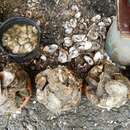Diagnostic Description
provided by FAO species catalogs
Shell medium sized, usually poorly sculptured, very variable in shape but generally higher than long, roughly rounded, oblique triangular or elongate ovate in outline. Left (lower) valve rather thick but lighweighted, more convex and larger than right (upper) valve, with small to large attachment area. Surface of left valve somewhat lamellate, with a few shallow to indistinct radial furrows that fainly scallop the commissure of valves. Right valve flattish, concentrically lamellate or nearly smooth. A moderately small umbonal cavity present under the hinge of left valve. Adductor muscle scar large, kidney-shaped, somewhat concave anterodorsally and a little nearer to ventral margin than to the hinge. Chomata completely absent from internal margins. Colour outside of shell dirty white, often flushed with pale greyish brown. Right valve frequently with a few darker purplish grey radial bands in early syages of growth. Interior of valves whitish and shiny, often with irregular areas of chalky white, deep purple-brown on posterior adductor scar.
- Anonymous - 1996. Annual Malaysian Fisheries Statistics, vol. 1. Depart. Fish. Malaysia, Min. of Agric., Kuala Lumpur, Malaysia.
- Devakie, MN & Ali, AB - 2000. Effects of storage temperature and duration on the setting and post-set spat survival of the tropical oyster, Crassostrea iredalei (Faustino). Aquaculture. vol. 190, no. 3-4, pp. 369-376 .
- Hawkins, AJS, Smith, RFM, Tan, SH & Yasin, ZB - 1998. Suspension-feeding behaviour in tropical bivalve molluscs: Perna viridis, Crassostrea belcheri, Crassostrea iradelei, Saccostrea cucculata and Pinctada margarifera. Mar. Ecol. Prog. Ser. vol. 166, pp. 173-185 .
- Poutiers, J. M. - 1998. Bivalves (Acephala, Lamellibranchia: Pellecypoda). In: The living Marine Resources of the Western Central Pacific. Volume 1. Seaweeds, corals, bivalves and gastropods. (Carpentier, K. E., Niem, V. H. eds) FAO, Rome, Italy .
Size
provided by FAO species catalogs
Maximum shell height 15 cm, commontly to 8 cm.
Brief Summary
provided by FAO species catalogs
Attached to hard objects or growing in bunches, on various soft bottoms, especially in bays and estuaries with somewhat reduced salinity. Intertidal and shallow subtidal water.Suspension-feeding (Hawkins et al. 1998).This brackishwater species is noted for its tasty creamy flesh and its culture requires a salinity range of 15-25 ppt. (Devakie & Ali, 2000).
Magallana bilineata: Brief Summary
provided by wikipedia EN
Magallana bilineata, commonly known as the Philippine cupped oyster or slipper oyster, is an economically important species of true oyster found abundantly in the western Pacific Ocean, from the Philippines to Tonga and Fiji. In 2020 an exotic population was discovered in north-east Australia. They grow attached to hard objects in brackish shallow intertidal or subtidal waters, at depths of 0 to 300 metres (0 to 984 ft). They are cultured extensively in the Philippines, where annual landings can range from 11,700 to 18,300 tons. They are known as talaba or talabang tsinelas ("slipper oyster") in Filipino to distinguish them from talabang kukong kabayo ("horse-hoof oyster", Saccostrea malabonensis)
- license
- cc-by-sa-3.0
- copyright
- Wikipedia authors and editors

